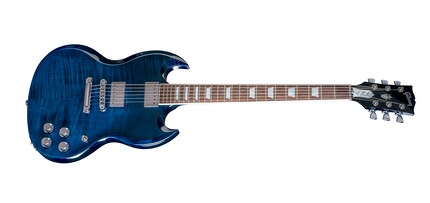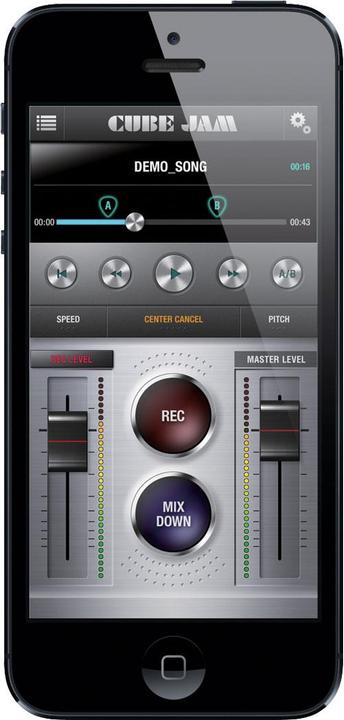
Multi-stringed: The PRS Standard SE 24
The PRS Standard SE 24 is a reasonably priced guitar with which you can create almost all kinds of sounds. A product presentation and a little background knowledge on how the sound of an electric guitar is created.
You may not even know that we also offer guitars. The musical instruments section is quite well hidden in the digitec shop. And so far, electronic tools for electronic music have dominated there.
Although I didn't quite make it to Jimi Hendrix in terms of hairstyle and guitar, I didn't want to miss the opportunity to get my hands on one of these things and write an article about it. This is not a product test, but I will give you some background knowledge so that you can better categorise the guitar. Because I'm guessing that you're not a professional guitarist, but rather someone who has just started to take an interest in the topic.

Types of electric guitars
Electric guitars are usually categorised into different types according to their design. For example, single cut and double cut. Compared to a classic acoustic guitar, almost all electric guitars have one or two cuts in the neck. These are there to make it easier for you to reach the top notes of the fretboard with your hand.


In addition, you will often come across the subdivision into ST models and T models. ST is the abbreviation for Stratocaster, T for Telecaster. Both guitars were developed by Leo Fender in the 1950s and are still built today in countless variations. The Stratocaster is also a double cut and the Tele a single cut, but because these two designs are so iconic, they deserve their own categories. In other words, if a Double Cut is more similar to a Stratocaster than to, say, a Gibson SG, then it falls into the ST category. This is exactly the case with the PRS Standard SE presented here.


These subdivisions have little influence on the sound. That is why there are further distinctions, such as whether the body is completely or partially hollow ("jazz guitars"). The most well-known semi-hollow guitar is certainly the Gibson ES-335.
If you want to differentiate between guitars according to their sound, it's best to look at the type and number of pickups
The pickup makes the music
The sound of an electric guitar depends on many factors. The most important is how you play. The amplifier and its settings also play a major role. But if we just look at the guitar on its own, the sound depends primarily on the pickups.

The photo shows a pickup of the PRS Standard SE 24. Most pickups are either single-coil pickups or humbuckers. Single coils have only one copper wire coil with magnetic pins, humbuckers have two. They are therefore twice as wide. The picture above shows a humbucker, easily recognisable by the two coils (black and yellow), each with a row of metal pins.
Humbuckers usually sound more powerful, fatter, louder and have more bass, but less clearly defined highs. Single coils tend to sound clearer, brighter and more bell-like.


The Stratocaster (left) has three single-coil pickups in its classic configuration, the Telecaster (right) has two. However, these guitars are also available with other pickups. Teles with two humbuckers or Strats with one humbucker and two single coils are popular, for example.
The PRS guitar has two humbuckers: one near the neck of the guitar (neck pickup) and one near the bridge (bridge pickup). This is one of the most common pickup layouts. For example, Gibson guitars and their numerous imitators usually have two humbuckers.
An example of the bright sound of single coils: [[video:91572]]
And here is an example of the darker sound of humbuckers: [[video:91573]]
Coil splitting: turn humbuckers into single coils
PRS offers a function called coil splitting on its guitars. This deactivates one of the two copper wire coils on the humbucker so that the pickup becomes a kind of single coil. Coil splitting is nothing totally out of the ordinary, but there are also many guitars that don't have this feature.

The PRS can do it and thus offers a rich spectrum of possible sounds. Humbucker on the bridge offers the fat and yet quite sharp tone that is so popular in rock. Single coil on the bridge is a little more cutting and easy to hear when soloing, even when the rest of the band is going full throttle. It is also suitable for country sounds. The pickup on the neck is very often used in jazz and blues.
However, I have to make it clear that the PRS never sounds exactly like a Telecaster or a Stratocaster, despite coil splitting. This is not possible with the Stratocaster because the neck and centre pickup or bridge and centre pickup can be used at the same time. This produces a very special sound that is sometimes referred to as a quack sound. Jimi Hendrix is a typical example of the neck-mid sound, Mark Knopfler (Dire Straits) of the bridge-mid sound.
But surprisingly, the PRS still comes a little close to the quack sound of a Stratocaster. To achieve this, the centre position, which activates both pickups, must be used in coil-splitting mode. The sound in the video is recorded directly from the guitar, i.e. without using or simulating a guitar amp.
A good starting point in the world of the electric guitar
The PRS Standard SE 24 is so named because the fretboard has 24 frets. That's exactly two octaves per string. The guitar also has a "sister" with only 22 frets. The advantage of slightly fewer frets is that the pickups can be placed a little further up, which means that the typical sound of the neck pickup is a little more pronounced.
Whether 22 or 24 frets - the PRS Standard SE is a guitar with a wide range of sound possibilities. It is also easy to play and surprisingly well made considering the favourable price. Highly recommended for beginners who want to and should try out everything first before developing a particular style.
By the way: This is the practice amplifier used in my video. It doesn't sound as bad as its diminutive size would suggest. And its design is geared towards the living room, unlike almost all other guitar amplifiers.
My interest in IT and writing landed me in tech journalism early on (2000). I want to know how we can use technology without being used. Outside of the office, I’m a keen musician who makes up for lacking talent with excessive enthusiasm.



